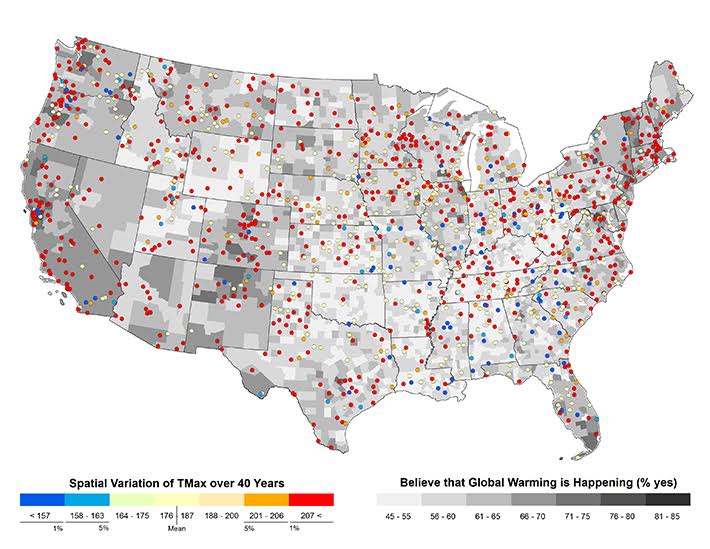The number of federal and state climate lawsuits has been growing since 2006, according to two George Washington University researchers who have conducted the most extensive study to date on the nature and impact of judicial resolution related to climate change.
This first-of-a-kind analysis determined air pollution and coal-fired power plants made up the bulk of the studied cases. In all studied cases, 58 percent were won by litigants opposed to government regulation. The analysis also shows pro-regulation plaintiffs won more than twice as frequently in cases involving renewable energy and energy efficiency.
This study was led by Sabrina McCormick, an associate professor of environmental and occupational health at the Milken Institute School of Public Health. Dr. McCormick worked with colleagues in the SPH’s department of epidemiology and biostatistics, the GW Law School and the university’s Trachtenberg School of Public Policy and Public Administration.
The courts are a central— but unappreciated—avenue for developing climate-related policy in the United States, Dr. McCormick said. The country is responding to climate change similarly to how it dealt with tobacco and chemical exposures, she said.
“In the coming months and years, judicial decisions that both support government action on climate change and serve to halt or slow such action will have a significant impact on our nation’s greenhouse gas emissions, energy development and biodiversity,” Dr. McCormick said. “These decisions will also play a key role in determining how our cities and society are able to adapt to climate change.”
Dr. McCormick and her colleagues looked at 873 judicial decisions between 1990 and 2016. They found the number of decisions mentioning climate science has been increasing, especially since 2006. One of the best-known cases is Massachusetts v. Environmental Protection Agency, which prompted the Supreme Court to cite climate science in 2007 when it enabled the agency to regulate carbon dioxide emissions as a pollutant.
The Massachusetts case is only one of hundreds of legal cases that addresses activities responsible for greenhouse gas emissions that have affected governmental decision-making, the authors said in “Science in litigation, the third branch of U.S. Climate Policy.” The study was published Thursday.
The GW team’s analysis revealed science was raised more frequently in cases arguing for regulation than in cases advocating against regulation. The analysis also shows the role of climate science in the legal decisions has grown in recent years.
A notable example of a case where climate science played a pivotal role is the 2009 decision by a U.S. District Court judge to overturn the U.S. Department of the Interior’s 2007 removal of the grizzly bear from the endangered species list. The 2009 decision was influenced by studies showing that climate change threatened the bears’ food sources.
“Litigation related to climate change is likely to grow in the next few years in response to actions by the administration and the Congress to roll back regulations dealing with greenhouse gas emissions and protections against the effects of climate change,” said Robert L. Glicksman, the J. B. and Maurice C. Shapiro Professor of Environmental Law at the GW Law School.
Experts anticipate the importance of climate science is likely to increase in future judicial decisions.
Cases to watch include the legal actions by the nonprofit Our Children’s Trust, which argues states are responsible for protecting children against the impacts of climate change. The lawsuit underway in Oregon relied on climate science to overcome important legal hurdles. Other similar suits are pending elsewhere across the country.
Courts are likely to respond to an increasing number of cases challenging failures by federal agencies to adequately consider the impacts of their decisions on climate change in the context of environmental impact assessments and implementation of the Endangered Species Act, the authors said.
Other countries have used novel legal approaches to deal more effectively with climate change, the GW research team noted. A district court in the Netherlands has ordered the Dutch government to take steps to substantially reduce greenhouse gases. This is based on decisions by the Dutch Supreme Court holding that government can be legally accountable for failures to prevent foreseeable harms to its citizens.
The reality of climate change is ever present and growing, Dr. McCormick said. City planners and local governments need to plan ahead for the impacts of climate change. Earlier this year in a separate study, Dr. McCormick led some of the first efforts to systematically assess how prepared cities are for extreme weather events.
Dr. McCormick conducted 65 interviews with people working in Boston, Los Angeles, Portland, Raleigh, Tampa and Tucson. She recommended steps cities should take to protect the public health and called on the public health community to provide information on local climate impacts and vulnerable infrastructure in urban areas.
“The Role of Health in Urban Climate Adaptation: An Analysis of Six U.S. Cities” was published in the journal Weather, Climate, and Society in August.




